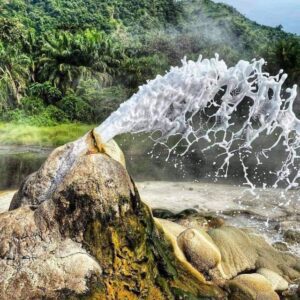The Kitagata Hot Springs, located on the Ishaka-Kagamba Road in Sheema District, southwestern Uganda, are approximately 350 km from Kampala.
Discovered in 1904, these natural hot springs are fed by the River Ngaromwenda and can reach temperatures of 80 degrees Celsius.
The springs are the result of volcanic activity, where water is heated underground and emerges to the surface with high temperatures and mineral content. The springs are also known as Ekitagata Kyamarembo, which means “the warm water” in the local language of Runyankole.
Known as “Ekyomugabe” or the King’s Spring, they attract hundreds of visitors daily due to their reputed healing properties.
This spring was used by the former king of Ankole, a traditional kingdom that reigned there until 1967. The water of this spring is very hot, reaching up to 80 degrees Celsius (176 degrees Fahrenheit). Locals may imply its capacity to boil eggs and make porridge from millet flour.
There are two primary springs, Ekyomugabe, which is larger and less crowded, and Mulago, named after Uganda’s largest hospital, known for its healing capabilities but smaller and hotter. Visitors often mix water from both springs to achieve their desired temperature.

The springs are surrounded by a bustling atmosphere with many half-naked individuals enjoying the warm waters, which are believed to alleviate various ailments, including skin diseases, muscle pain, and chronic conditions.
The site features designated areas for women and children, while men have their own section. The hot springs have a cooking temperature on one side and a more moderate warmth on the other.
Some visitors come to collect water in jerry cans for home use, while others perform rituals for spiritual benefits.
Unlike Uganda’s national parks where entrance fees are set, at Kitagata Hot Springs, it is free entry and exit. Some tourists inquire about the cost for using the hot springs, or how much they should pay to tour the area.
Currently, climate change worries the locals. They have noticed that when it rains, River Ngaromwenda, the river that supplies water to the springs, floods and the springs become almost cold.
According to the locals, “the Interference of the hot spring’s water system was tampered with by the construction of Ishaka Kitagata Kagamba road”
The Kitagata Community Hot Springs Management Committee, formed in 2021, saved the natural treasure by diverting floodwaters, building sandbag barriers, and educating locals on conservation.
Today, the hot springs remain accessible, providing healing and income for the local community.
Exploring these hot springs will give you a proper insight into what Uganda is all about especially when it comes to culture and nature.